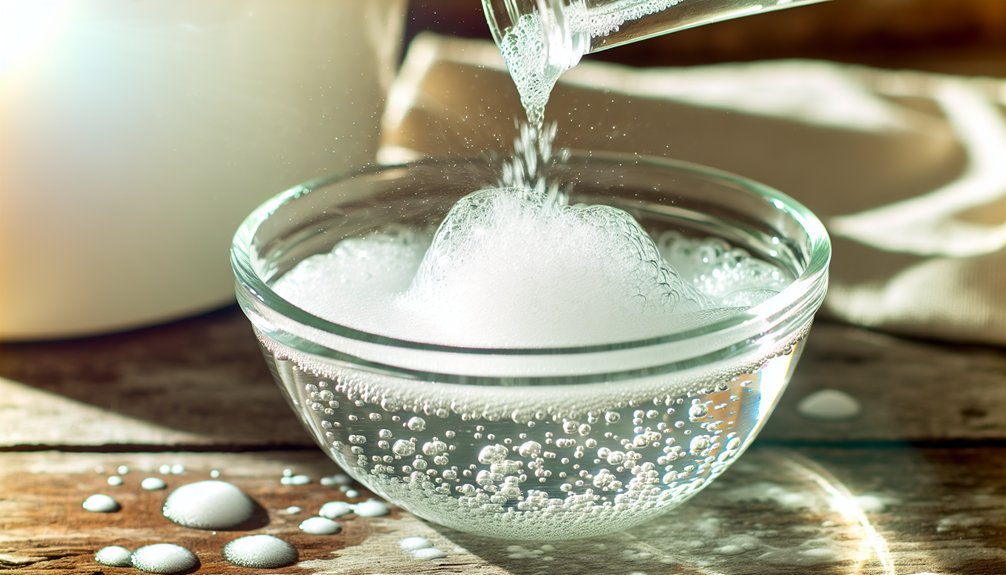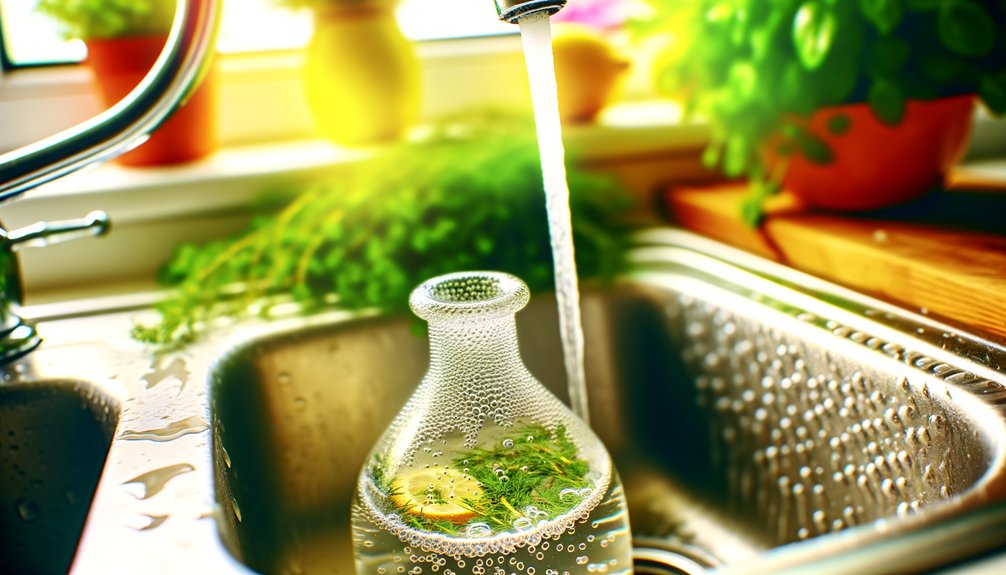Vinegar solutions effectively clear clogged drains, particularly when combined with baking soda. The process involves pouring ½ cup of baking soda followed by 1 cup of vinegar into the drain. This creates a fizzing reaction that helps break down grease, hair, and soap scum. For persistent clogs, a salt and hot water technique may be employed, utilizing ½ cup of salt followed by 10 cups of boiling water. Further insights on maintenance strategies and additional techniques await.
Baking Soda and Vinegar Method

The Baking Soda and Vinegar method serves as an effective solution for unclogging drains. This technique involves pouring ½ cup of baking soda followed by 1 cup of vinegar down the clogged drain. The resulting fizzing action initiates a chemical reaction that produces carbon dioxide gas, helping to break down grease, hair, and soap scum. To maximize effectiveness, it is advisable to let the mixture sit for 15 to 30 minutes before flushing the drain with boiling water. Regular maintenance using this method can serve as a preventative measure, maintaining clear drains and reducing the presence of odor-causing bacteria and fungi. This eco-friendly approach is a safe alternative to harsh chemicals, making it a cost-effective solution for minor clogs in most plumbing systems. By incorporating baking soda and vinegar into routine cleaning, individuals can liberate their drains from persistent blockages while promoting overall plumbing health.
Salt and Hot Water Technique
A highly effective method for addressing clogged drains involves the Salt and Hot Water technique, which specifically targets grease and soap buildup. This technique begins with pouring ½ cup of salt down the clogged drain, allowing it to sit for five minutes. The salt serves as an abrasive agent, helping to break down stubborn grease and soap scum. Subsequently, boiling 10 cups of water and carefully flushing the drain can effectively melt and remove hardened blockages. This method is particularly beneficial for kitchen sink clogs caused by the accumulation of grease and oil. Regular application of the Salt and Hot Water technique can greatly aid in maintaining clear drains and preventing future clogs. By utilizing this straightforward approach, individuals can liberate their plumbing systems from unwanted obstructions, promoting better drainage and overall efficiency.
Preventive Measures for Clog Prevention

Maintaining clear drains requires a proactive approach to prevent clogs before they occur. Disposing of fats and oils in a trash container is essential, as pouring them down the drain can lead to considerable buildup. The installation of drain strainers or guards in sinks and showers effectively captures hair and food particles, mitigating blockage risks. A recommended drain maintenance method involves flushing drains monthly with a mixture of baking soda and vinegar, which assists in breaking down potential buildup. Additionally, pouring boiling water down drains weekly serves to dissolve lingering residue and further prevent clogs. Implementing these homemade solutions alongside regular plumbing inspections allows for the identification of potential issues, ensuring a free-flowing plumbing system. By adhering to these preventive measures, homeowners can considerably reduce the likelihood of clogs, thereby promoting a healthier and more efficient drain system.
Frequently Asked Questions
What Vinegar Is Best for Unclogging Drains?
In evaluating the best vinegar for unclogging drains, white vinegar emerges as the superior choice due to its high acidity and cleaning effectiveness. Apple cider vinegar, while a viable option, is less effective, primarily due to its lower acidity and sugar content. Utilizing these natural cleaners not only aids in drain maintenance but also promotes odor neutralization and pipe safety. These eco-friendly solutions serve as effective DIY remedies, offering practical kitchen tips for drain care.
Do Baking Soda and Vinegar Really Unclog Drains?
Studies suggest that nearly 80% of clogged drains are due to organic materials, making baking soda and vinegar a popular choice for DIY unclogging techniques. These natural cleaning methods utilize baking soda reactions with vinegar, creating fizz that helps dislodge common clogs. Plumbing myths debunked, this eco-friendly solution serves as an effective household remedy. Preventative measures suggested include regular application, promoting drain maintenance tips for long-term effectiveness and minimizing future blockages.
How Long Do You Let Vinegar and Baking Soda Sit?
When using vinegar and baking soda for drain maintenance, it is essential to allow the mixture to sit for 15 to 30 minutes, maximizing the vinegar cleaning benefits. For enhanced home remedy effectiveness, extending the duration to 30 to 40 minutes is advisable. Baking soda reactions create fizzing that helps break down clogs. Regular application every one to three months serves as an eco-friendly alternative, promoting effective drain cleaning frequency and preventing future blockages.
How Long Should You Let Vinegar Sit in a Drain?
Statistics reveal that over 80% of household drain blockages stem from organic materials. For effective drain maintenance, vinegar should ideally sit for 30 to 40 minutes to maximize its unclogging benefits. A comparison of vinegar types highlights their effectiveness as eco-friendly unclogging methods. Incorporating homemade drain cleaners and plumbing DIY solutions into routine kitchen sink care can alleviate issues. This natural cleaning alternative not only combats blockages but also promotes long-term drain health through consistent vinegar usage.



